| About Us | Contact Us | Contact Database | Support Us |
- MANUAL-
Local Organizations managing Sustainable Energy
When new solutions are introduced, it is important that involved organizations,
companies, and users are able to handle the new tasks they get. Often
the best solution is to create a new local organization, formal or informal,
to handle some of the new tasks. This chapter gives an overview of some
of the most used and the most successful organizations and structures
to manage local sustainable energy solutions in South Asia.
4.1 Planning and implementation of RET projects by Grameen Shakti in
Bangladesh
Grameen Shakti (GS) uses short feasibility studies, reports from the
field to plan and implement its projects. In many cases, short duration
pilot projects are carried to test or fine tune an idea. For example,
before opening a unit office on a new site, GS carries out a short feasibility
study to find out the market potential of Solar Home Systems (SHSs) on
the new site and whether it would be financially viable to open a new
unit office there. Field staff focus on the following when carrying out
their analysis: (i) no possibility of grid coverage in the near future
(5 to 10 years); (ii) interested of people in SHSs; (iii) purchasing
capacity of prospective buyers/customers; and finally (iii) total demand
to ensure a operation of unit office on a sustainable basis, i.e. there
would be at least 350 customers over the next three years.
Over the years, GS has developed in-depth understanding of the rural
market. This has been achieved through continuous gathering of data through
its wide network of field staffs and unit offices. These extensive data
helps GS to develop new products and programmes as well as fine tune
its existing programmes. For example, one of the surveys carried out
by GS, showed that there was a potential market for new devices such
as DC-DC converters, safety devices for black & white television
sets, solar powered mobile phones, micro-utility models etc. Later, GS
developed these products in response to client needs.
4.2
Communities & Women
Involvement in RET implementation by GShakti in Bangladesh
Involvement of the local community is vital for the successful operation
of Grameen Shakti (GS) renewable energy programme. Right from setting-up
the GS gives local communities control over solar installations in their
areas. This is achieved by GS working with teachers, community leaders
and elected officials, who are explained the benefits of the solar home
systems to the people they represent. Another important aspect of the
local involvement is the manufacture, repair and maintenance of solar
accessories close to the communities that are served by GS, by people
who are familiar with their needs.
The main focus of GS is women who are always involved with its various
programmes. For instance, women from end-user families have been trained
as technicians by GS staff so that they can take care of the day-to day
maintenance of their Solar PV systems.
From experience GS has learnt that it is more viable to train women than
men as the men are in jobs outside their homes. Moreover, women technicians
would find it easier to enter the ‘End Users’ homes when
the only members available are women-folks as their men-folks are working
outside their village. GS has also facilitated empowerment of women by
providing them opportunities to earn their livelihood through business
ventures such as solar powered mobile phones, home based poultry, handicraft
businesses etc .
4.3 Trading Methods and Organizations
in Sri Lanka
Sri Lanka Stoves Program has two different routes for dissemination of
stoves:
1. Commercial Route: In the commercial route there are 185 potter families
distributed in 17 districts producing over 25000 stoves monthly. However
almost 50% of the production is concentrated in one village consisting
of 29 potter families who produce stoves in large quantities.
A survey revealed that nearly 65% of stoves sold to the traders are on
spot cash 31% who had received a cash advance before and 3% were sold
on credit. Many of the producers have regular dealers. However the producer
dictates the terms since demand far exceeds the production level.

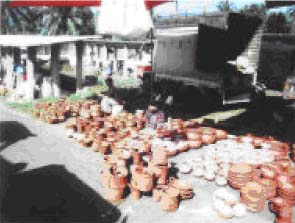
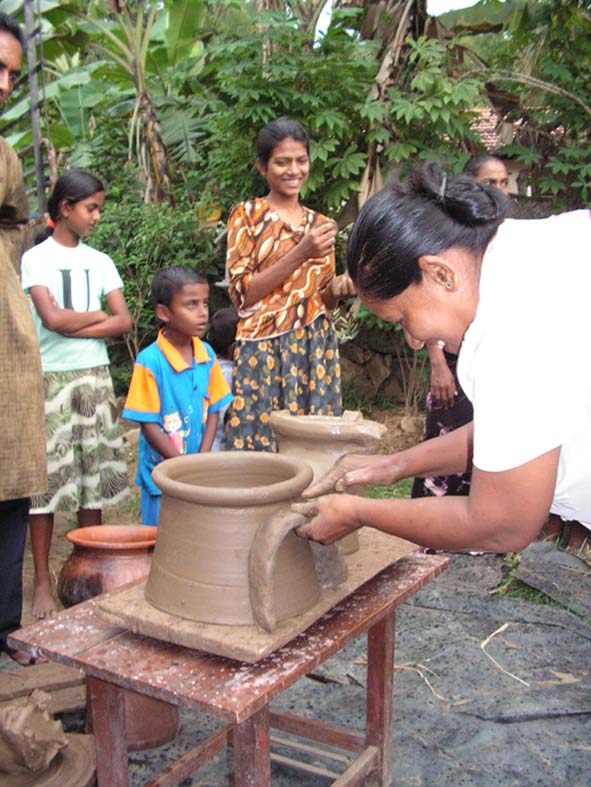 Modes of selling between producers and traders can be classified
as below:
Modes of selling between producers and traders can be classified
as below:
-
Producers sell to wholesale dealers visiting the site.
-
Producers themselves deliver to outside retailers directly.
-
Producers themselves deliver to wholesale dealers outside.
-
Small producers sell in the village.
-
Producers sell to the producer coop society.
-
Producers sell to Producers who are also wholesale dealers.
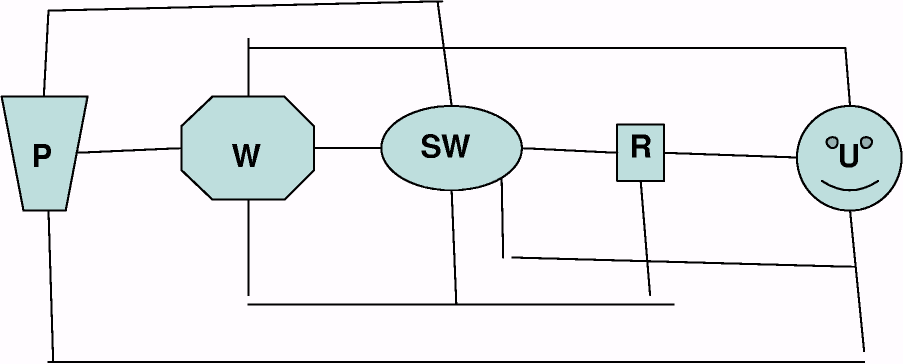
P= Producer
U= User
W= Wholesale Dealer
SW= sub wholesale dealer
R= Retailer
In the case of small scale isolated producers where traders do not call
over, the stoves are the taken to the village fair and sold directly
to the users. In places where the commercial route is operating stoves
are bought from retail shops. However there are also street vendors
who deliver the stoves to the user.
2. Dissemination Route: While the commercial route is mainly a traders
affair, in the dissemination strategy, NGOs establish a revolving fund
to facilitate
the users who live in isolated areas who have no access to the commercial
route to purchase stoves which are bought by the NGOs from either producers
or traders and distributed to the users. Users pay the cost of the stove
in installments. In the dissemination route, a small profit derived by
selling the stoves is used to enhance the revolving fund to reach a wider
group of users. If funds could be obtained from donors users are given
stoves at subsidized price.
4.4 Self-Help Groups of Women’s for the promotion
of Hh Biogas Plants in India
AIWC had been implementing household biogas plants, under the centrally
sponsored, National Project on Bio-Gas Development (NPBD) of (MNES),
Govt. of India, since 1994, as one of the Nodal Agencies for channeling
funds (for subsidies, turnkey fees and trainings) to grassroots NGOs.
The technical support was provided by a national level technical support
organisation, who had developed the popular Deenbandhu biogas plant.
This programme was conducted through AIWC branches in various states
as well as other NGOs as partners.
AIWC had conducted more than 15-20 day bio-gas training programmes for the construction and maintenance of bio-gas plant and built over 10,000 plants.
- One of the branches of AIWC at Chunar, which is half way between Varanasi and Mirzapur in the state of Uttar Pradesh is working with nearly 800 women belonging to Self Help Groups (SHGs) providing training in various income generating trades like carpet weaving, pottery making, etc and employing them.
- This branch had taken up the AIWC NPBD programme and had implemented a very successful biogas dissemination and implementation programme, constructing 300 biogas units in this area. Since women were directly involved in this programme even after four years of implementation almost all the bio-gas units are being used by the end users, which has also created very big demand for construction of bio-gas plants.
- The husband of one of the beneficiaries “Laxmi” was running a poultry farm where they had around 150 birds in the big terrace in their house and through AIWC biogas programme they had built a 4 cum capacity unit in their backyard, which were fed with poultry litter and producing substantial quantity of bio-gas every day to all the needs of a joint family of 15 as well as their poultry farm workers. The pressure of gas was so high that at times they had to release the excess biogas it to reduce the pressure.
- Laxmi was happy with the biogas as now she doesn’t have to use any other fuel in her house for cooking, but it has become a source of additional income for her, as she started supplying bio-gas to 6 to 7 houses nearby and charging them for the gas. She also had more surplus time and started working with AIWC branch at Chunar, which started giving her more self confidence. With the improvement of health due to reduction in indoor pollution as a result of use of biogas as a clean fuel for cooking, her standard of her life also improved, leading other women of the self-help group to follow her example, which created good positive impact on the socio-economic situation of the women in Chunar.
A group of women who are members of self help group (SHG) run by our partner NGO in Kakinada in Andhra Pradesh state have got their biogas units constructed under the AIWC bio-gas programme by taking the loans from their respective SHGs or building biogas. They have returned the entire loan with interest and are happily using their biogas, for cooking, lighting, and using the biogas digested slurry for their kitchen gardens and agricultural fields. There is great demand for more biogas units.

AIWC experience had been that wherever the women of the house had been trained in the use of biogas the correct way of feeding, maintaining etc. the units are always working well since the women have understood the importance & the benefits of using these bio-gas units. These two examples demonstrate that women SHG could provide one of organizational solutions for the effective means for promoting any affordable rural oriented RETs.
4.5
Village/User Cooperatives & Societies-
Denmark experience that can be applied in South Asia
With cooperatives people are able to do things that they could not do
alone. They can buy, sell, and process
food and materials on large scale. They can employ people with skills
they need. They can become independent
of suppliers or services they find inadequate.
During the last century cooperatives have been crucial for the successful
development of many of the richest countries of the world, such as the
Danish farmer cooperatives that helped to establish Danish agricultural
exports (Denmark is today the fourth richest country per capita).
Cooperatives can be crucial for activities that private investors will
not invest in because the profits are too small.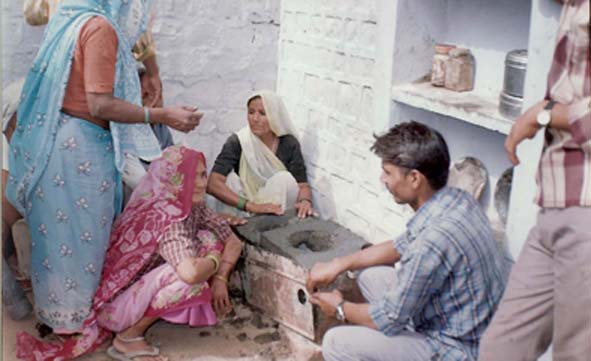
The main types of cooperatives are:
-
consumer cooperatives, where consumers own their shop, electricity provider, water supply etc. together (in some countries called consumer societies)
-
producers' cooperatives, where farmers sell their products together, own diaries together.
Cooperatives
are company structures, not social structures. They can involve poor
people and make their development easier, but
they do
not necessarily bring new resources to end poverty.
In a cooperative each member pay an entrance fee (share) according
to his or her needs for the service the cooperative provides
and sometimes additionally gives a guarantee. Then the members
can use the service
and pay or receive money depending on the kind of cooperative.
The cooperatives
are either non-profit companies or pay their profit to the
members of the cooperative according to the share or the actual
use of
each member.
Often cooperatives are limited companies where the members
can never loose more than their share + their eventual guarantee.
In cooperatives
the general rule is that each member has one vote.
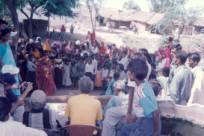
Cooperatives have been important in development of energy supply, owning power plants, electric grids and many other supply structures that a family or a small company cannot afford alone. This is the case in many countries of the world. Energy cooperatives to reduce poverty can include:
- Village cooperatives that establish small hydropower & mini grid (see case from Sri Lanka).
- Village cooperatives to establish local power supply e.g. from wood gasification, engine, PV.
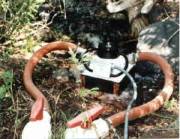 Consumer cooperatives
for maintenance, such as repair of PV and biogas installations.
Consumer cooperatives
for maintenance, such as repair of PV and biogas installations.- Farmer cooperatives that produce vegetable oil for transport (e.g. Jatropha oil) or bio diesel.
- Farmer cooperatives that produce fuel (e.g. charcoal briquettes) from agricultural residues.
To work successfully, cooperatives must be adapted to the societies
they are part of and they must have the necessary skills
and facilities for
the types of businesses they are doing. In addition they
must have a leadership and a board of members that actively
work for
an efficient
operation of the cooperative aiming at the highest benefits
for the members.
Like any other business, cooperatives are not free from
problems. Problems to look out for are:
-
That the cooperative work as efficient as a good private company
-
That the management does not take private benefits from the operation or give special benefits to some people. This has been a serious problem in areas where there is little experience with cooperatives or where the business morale for some reason degrades.
-
That the conditions for the cooperative can change so much that the benefit of the cooperative for the members does not exist any longer. Then a restructuring is necessary, based in an analysis of the development and of the opportunities, and a general discussion among members.
-
Dissatisfaction among members. To avoid that, cooperatives must have the maximum openness in its operations. Members must know precisely why they pay for. Further, they must have opportunities to suggest improvements.
How to form a cooperative:
-
First there must be a need for the service that a cooperative can provide (such as lack of rural energy supply) and ideas to solve it (such a local energy supply)
-
An overview of available legal structures is important, and then to choose the best available option (few lines about available structures in the four countries, such as the structure “limited cooperative” when it exist)
-
A business plan that makes it clear to potential members what they get, what they pay and what they risk. The business plan should be based on best available information including experience from similar activities, eventual subsidies that can be given, etc.
-
Information to potential members
-
Creation of a list of interested members. Usually the cooperative can only be established if a minimum number of members join.
-
Bylaws should be developed, usually based on existing bylaws from similar cooperatives
-
A general assembly is the formal start of the cooperative. It also elects the board that starts the operations.
4.6
Decentralised Power Generation using Solar PV system in remote
Non-Electrified area, Operated and Management by Producers-cum-Consumer
cooperative- A case of Sagar Island, India
Sagar Island is a large island with an area of around 300 sq km spread
over 43 villages and a population of over 1.60 lakhs, situated 110 km
south of Kolkata. One of the main problems of the people of Sagar Island
had been non-availability of grid electricity. Till 1996, there were
only a few Diesel Generating sets with total capacity of 300 kW were
providing electricity to a few selected 400 consumers, and too for a
few hours in the evening. The operation and maintenance requirements
of these generators were quite high and at the same time causing adverse
environmental pollution.
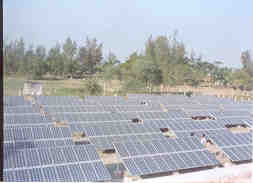
In 1996, Sundarban Region was identified by MNES as one of the high priority
area under its Solar Photovoltaic (SPV) Programme and gave necessary
funds to WBREDA (West Bengal Renewable Energy Development Agency) for
setting up of SPV Power Plants there.
As a result of MNES funding, in February 1996, the WBREDA set up and
commissioned the very first 26 kWp SPV Power Plant at village Kamalpur
in Sagar Island, with only 19 consumers.
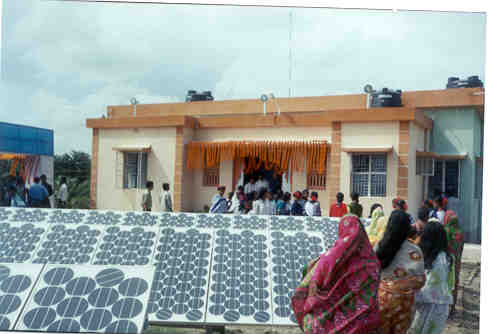 At present many such power plants with aggregate SPV capacity of 300
kWp are in operation in Sagar Island providing electricity to around
2,000 households. These Power Plants have been set up with financial
support from the MNES and the State Government, as well as soft loan
assistance from the Indian Renewable Energy Development Agency (IREDA)
under the World Bank assisted SPV market development programme.
At present many such power plants with aggregate SPV capacity of 300
kWp are in operation in Sagar Island providing electricity to around
2,000 households. These Power Plants have been set up with financial
support from the MNES and the State Government, as well as soft loan
assistance from the Indian Renewable Energy Development Agency (IREDA)
under the World Bank assisted SPV market development programme.
At present, more than 50% of the total electricity consumed in Sagar Island is provided by solar energy generated electricity, through SPV systems, which also includes operation of essential services, like hospital services, water supply, etc.
The unique Features of SPV Programme at Sagar & Moushuni is that these SPV power plants are being run on commercial mode through the local rural co-operatives formed by the beneficiaries themselves under the aegis of WBREDA, catering to both the domestic & commercial needs for 5-6 hours in the evening daily. For obtaining a connection from the power plants, the end-user, is required to pay Rs.1,000/- as connection charge. Thereafter, each household (end-user) pays a monthly charges, ranging from Rs. 130/- to Rs. 1,300/-, which depends upon the connected loads, which are in the range of 100 to 1000 watts.
The distinguishing feature of the SPV decentralized power programme in both Sagar as well as Moushuni islands is the integration of power & water supply systems in these projects. The power plants have been designed to operate low cost conventional water pumps of average 3 HP capacity with an intelligent controller during daytime to provide drinking water without incurring any extra cost, except installation of some additional SPV modules. Around 700 families are getting the twin benefits of such integrated power & water supply systems at present in the twin Islands of Sagar and Moushuni.
This decentralized power generation venture utilizing SPY system, has opened up a new opportunities for meeting two basic needs of electricity and water together, of the dispersed population of the isolated & remote habitats having no alternate or traditional energy sources, in a meaningful way.
4.7
Village Hydro Power Consumers’ Societies
in Sri Lanka
In Sri Lanka, 65% of households have access to the national electricity
grid. Majority of the rest use kerosene for lighting. Within the next
10 years, the total electrified may reach 75% of households. The government
has implemented the renewable energy for rural economic development
project (RERED) with the support of the World Bank and UNDP (GEF).
This programme is implemented to promote the use of micro hydro, photovoltaic
or biomass in households not serviced by the national grid. The main
component of this project is a credit programme to provide medium and
long-term financing for private project developers, NSOs and community
cooperatives, so that the household electricity can be provided by
renewable energy options. The project runs from 2002 to 2007.
 Under this programme it is planned to install 90 schemes with a total
capacity of 3762 kW ranging from individual capacities of 2.6kW to 40
kW to provide electricity to 3762 households. At end of Dec 2004, 31
micro hydro schemes were completed providing electricity to 1979 houses.
The rest of the projects are in progress. At present it is estimated
that nearly 250 off grid village hydro schemes are in operation in Sri
Lanka.
Under this programme it is planned to install 90 schemes with a total
capacity of 3762 kW ranging from individual capacities of 2.6kW to 40
kW to provide electricity to 3762 households. At end of Dec 2004, 31
micro hydro schemes were completed providing electricity to 1979 houses.
The rest of the projects are in progress. At present it is estimated
that nearly 250 off grid village hydro schemes are in operation in Sri
Lanka.
One of the villages covered under this programme is "Waturawa" is
a small village with a population of 250 people living in 45 houses situated
in the Ratnapura District famous for gems in Sri Lanka. It is 10 km from
the closest town and accessible by public transport. The main occupation
of the villagers is agriculture. The national electricity grid is 4 km
away and it is unlikely that the grid will be extended within the next
two decades.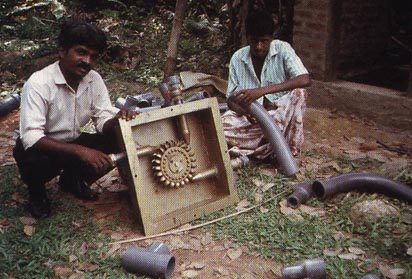
The main energy sources
in the village are firewood for cooking, kerosene for lighting and
few using car batteries
to watch TV. Each household
spends about Rs 500/month to meet the energy needs. The village receives
an annual rainfall of 4000 mm. The terrain of the village is hilly and
a perennial stream runs through the village. This stream was exploited
to provide electricity to the village. Since the houses are scattered,
only 25 houses could be electrified. The electrification was carried
out by IDEA as the project developer under the RERED programme.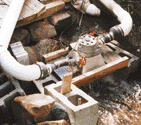
After careful sensitization and building confidence of the village members,
a consumer society was formed. The office bearers were trained to take
on the appropriate responsibilities to run the project on a sustainable
manner. Feasibility study and loan documentation were completed by IDEA.
Processing of the loan took about 4 months.
After confirmation of the loan, each household was expected to contribute
Rs 4000 (33 Euro) initially to the society funds and provide labour services
on a voluntary basis in the construction of civil works and distribution
lines. The electrical and mechanical equipment were made by local manufacturers
trained by the ITDS. All unskilled labour for the civil works was provided
by the members and carried out under the supervision of IDEA. The society
was able to secure Rs 200,000 from the provincial council to meet the
initial cost. The construction work was completed within a period of
nine months. The society charges a fixed monthly fee of Rs 600 (5 Euro)
from each household for the use of electricity. It is virtually the loan
component payable by the society/member to the bank. The loan was released
by the bank after the certification provided by a chartered engineer
appointed by the bank, that took nearly six months after completion.
The grant of SL Rs 400,000 obtained under the RERED project was invested
in a bank and the interests received is maintained as a separate fund
to meet the cost of maintenance and operations.
The society has managed the scheme in a very good manner for the last
two years. There has been enough water throughout the year for continuous
operation despite the drought conditions experienced in the dry season.
The power generated is used mostly for lighting, ironing and watching
TV. All the 25 houses have colour TVs and electric irons and refrigerators
in 4 houses. Initially only CFL lamps were allowed but fused CFLs are
often replaced with incandescent lamps due to high cost. Members are
however requested to avoid the use of incandescent lamps, heating equipment
and refrigerators during peak hours. During the day time the power is
supplied to a 1.5 HP chili ginding mill.
The only major problem encountered has been the flooding of the power
house, which costed Rs 20,000 for the repairs of the electrical equipment.
4.8
Micro-utility Model in implementation of Solar PVS by Grameen Shakti
in Bangladesh
Only 30% of the Bangladeshi people have access to grid electricity and
most of them live in the cities. There cannot be any economic development
without electricity. Because of this, rural communities suffer from under-utilized
economy and depressed business activities. Mobility of people is also
hampered after dusk due to security problems. However many people cannot
afford Solar Home Systems individually. This is one of the barriers to
the scaling up GS solar programme and revitalizing rural economy through
the use solar PV technology, that many people cannot afford Solar Home
Systems individually.
The Grameen Shakti’s “Micro-utility model” Solar Energy
Programme has been initiated to address these vital issues of extended
business hours for increasing business turn-over. The GS’s “Micro-utility
model” scheme is meant
GS has therefore, developed this special programme to make it easier
for those who cannot afford SHSs individually and to become owner of
one. Under this programme, GS facilitates a group of people to share
the cost and benefit of using a Solar Home System (SHS). This programme
is based on ownership model because this ensures individual responsibility
The purchaser of the SHS is considered the owner of the system and is
responsible for re-paying installments to GS. The due amount is paid
to GS by renting his lights to other people especially to his/her neighbours.
This scheme especially targets the petty shop keepers in rural and semi
urban areas, which are not connected with grid electricity.
GS took up an intense promotional campaigning among the shopkeepers to
popularize this model. The GS also developed an attractive package to
create interest among the shopkeepers community to make them owners of
SHSs under this model.
Under this scheme, the entrepreneur
or the prospective owner of SHS does not have to pay any service charges
and gives a small initial down
payment of only 10% and gets his SHS installed. By regularly paying his
installment, he would become the owner of the SHS in three and a half
years. This strategy yielded the amazing results and thus Micro- utility
model has become extremely popular among the shopkeeper’s community.
Till date, more than one thousand SHS’s have been installed under
this scheme. This model of implementation has helped GS to tie solar
PV technology with income generation, thereby bringing the greatest benefit
to its end-users. This has also helped GS to scale up its programme by
reaching those who cannot afford a SHS individually- GS has thus able
to install more than 2000 SHSs.
One such shopkeeper Mr. Umor has a grocery shop at Kormal bazaar. He
has bought a solar home system with six lamps. He is using one lamp himself
and renting the other lamps to neighbouring shops for a fee of 7 cents
per night/ lamp. In this way he has increased his income and the income
of the neighbouring shops.
The growing and striking impact of Micro-utility model is that it has
increased business turnover and extended business hours in rural bazaars.
Now shopkeepers can afford pollution free, efficient lighting at minimum
costs and keep their shops open after dusk- thus more business. Customers
also enjoy greater mobility- freedom and can come to the markets after
dusk.
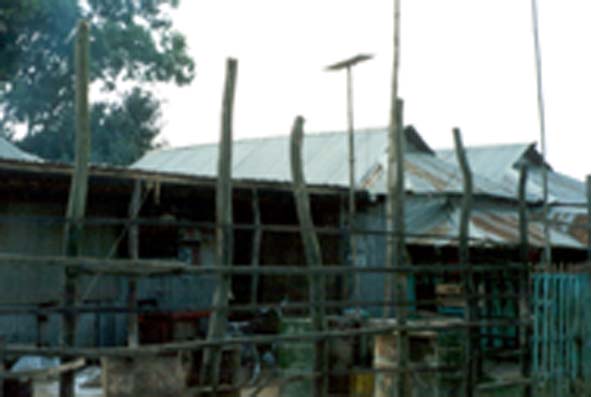
Micro-utility Model in a market place
There is reduced health risk and less danger of fire because kerosene lamps are not being used. Women also enjoy greater mobility and freedom because their security is increased due to better lighting system. The applied technology is highly upgraded one but easy and people friendly. After making full payment, there is very little additional cost involved. The capital cost of SHS is recovered in 3-4 years. Lighting is available for almost 4 hours per day.
4.9
SPV Lanterns for Mobile Stall by Poor Couple Food for Income Generation,
AIWC, India
Elliot Beach in Chennai.-Madras The “Other” beach of the
city– as against Marina, to the north is becoming increasingly
popular as the evening destination of the people, especially from the
nearby residential areas, Of late, a number of small stall have sprung
up, which function in the evenings, from about 6 pm to 10 pm selling
small eats- chilly cutlets, wafers, etc, and some offering amusements
like shoot the balloon, darts etc. In the beginning about 20 of these
stalls used solar lanterns.
Chandran and his wife, who are residents of a nearby fishing village,
run a vegetable cutlet stall. They have two lights which they take from
a nearby house. An enterprising person there had purchased about 24 Solar
lamps, takes an advance of Rs. 100/- per light and Rs. 10/- per light
per day after 10 pm they return the lights to the owner who gets them
charged for the next day, keeps them ready for use in the evening.
Chandran and his wife make about Rs.50 to Rs.75 on week days and Rs.100
to Rs.150 on the evenings of week-ends. They have no problem in paying
the one time deposit of Rs. 100/- and the daily charge of Rs.10/-per
light. They say the Solar lamps give light for a little more than 4 hours
and functions well, which is enough for them. They do not have to buy
Kerosene for the petromax lights they were using earlier, and they don’t
have to buy those lights or spend a lot of time cleaning them. Their
hands also used to smell of kerosene, which was not relished by the customers!
And the solar lights are not “hot” to remain closer to it.
They are very happy with the solar lights. It not only prevents kerosene pollution on the beach but also proves profitable to the enterprising persons who rents them out on daily basis. Now 3 years later there are hundreds of Solar Lanterns being used along the beach and it is a beautiful sight to see in the evenings.
4.10
Role of Rural Energy & Ecological
Volunteers Corps (REEVOCs) in RE promotion India
The village level volunteers group, called as REEVOCs (Rural Energy
and Ecological Volunteers Corps) has played an important role in the
implementation
and management of renewable energy (RE) programmes in 12 Eco-villages.
These villages are being jointly promoted and developed by WAFD and INSEDA
under the “eco village development projects”, since April
2002.
The last 4 ½ years of experiences in the “eco village development
project” has shown that unless a community has ownership of a programme
and is involved at all levels from planning, implementing, monitoring
and evaluating, long term sustainability is not possible. The EVD project
being implemented in 12 villages of Sewar Block in Bharatpur District
of Rajasthan state, has successfully demonstrated this.
The steps followed in this process are summarized below:
- A group of 4 volunteers were selected from each village, 2 men 2 women making a total of 48 volunteer group, called as REEVOCs
- For 2 years this group (entire 48 volunteers) met at least once a month and learnt about the importance of eco village development and it’s relevance in today’s world, and the important role that renewable energy plays in this; and
- It is important to target each important group in the village, to achieve this, these volunteers helped promote and organize, in their villages, women’s groups and youth groups, and carried out implementation and demonstration of among other things renewable energy units.
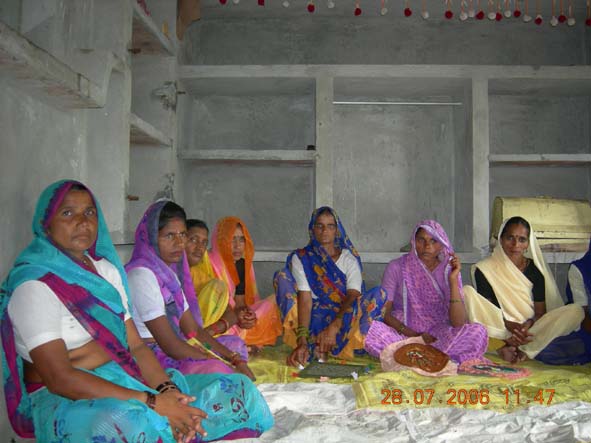
After four years of implementation these volunteers (REEVOCs)
have understood the importance of eco village development,
and the role
of renewable
energy such as biogas plants, plantation of energy crops
like Jatropha, and solar energy. In addition they have
also become
aware about the
production of SVO (straight vegetable oil) and bio diesel
from non-edible oil seed
like Jatropha seeds for operation of diesel pumping sets,
as well as decentralize power generation at the rural
household and village
levels,
by using bio-diesel operated generating sets. They are
now motivated to undertake Jatropha cultivation on the boundaries
and their other
wise unproductive waste lands.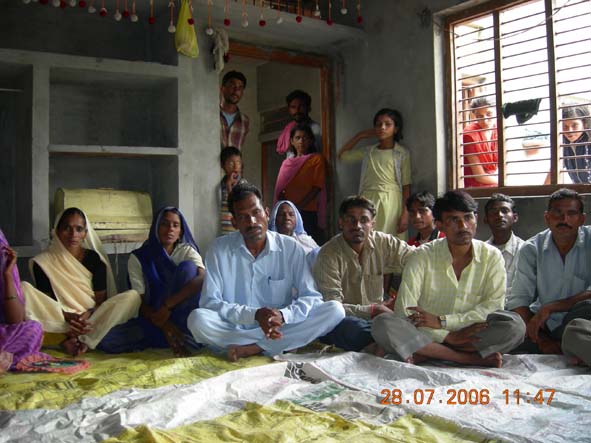
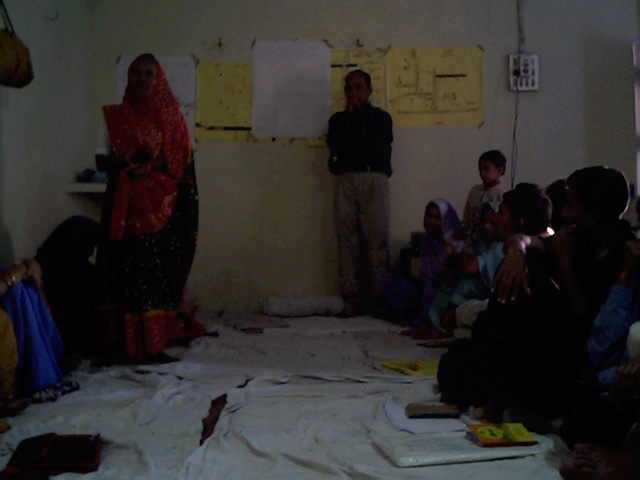 Now for more systematic and organized implementation of
RE and other related activities in an integrated manner
for
desired output/results
in a foreseeable future, the 48 REEVOCS have formed a “management
committee”. This “management committee” has been elected
by the volunteers themselves which has one representative from each of
the 12 project villages. The management committee in tern has elected
6 office bearers- out of them three are the key office bearers, i.e.,
President, Secretary and Treasurer, to oversee the day to day operation
aspects of the programmes in these 12 eco-villages. The other office
bearers are, Vice president, Joint Secretary and Joint Treasurer. The
office bearers take more responsibilities on behalf of the management
committee and meet more frequently during the inter-sessions of the management
committee meetings and are delegated to meet the district level government
functionaries to present the problems of the group as well as find out
appropriate government programmes to implement in these 12 villages.
Now for more systematic and organized implementation of
RE and other related activities in an integrated manner
for
desired output/results
in a foreseeable future, the 48 REEVOCS have formed a “management
committee”. This “management committee” has been elected
by the volunteers themselves which has one representative from each of
the 12 project villages. The management committee in tern has elected
6 office bearers- out of them three are the key office bearers, i.e.,
President, Secretary and Treasurer, to oversee the day to day operation
aspects of the programmes in these 12 eco-villages. The other office
bearers are, Vice president, Joint Secretary and Joint Treasurer. The
office bearers take more responsibilities on behalf of the management
committee and meet more frequently during the inter-sessions of the management
committee meetings and are delegated to meet the district level government
functionaries to present the problems of the group as well as find out
appropriate government programmes to implement in these 12 villages.
The role of this management committee is to sit with WAFD and take an active part in planning, implementation, evaluation and monitoring of the programmes, which will have focus on community-centered poverty reduction, by integrating REs in all the socio-economic developmental programmes. Field level monitoring and decision-making is done much more effectively by the committee. Solutions to problems are found by the committee jointly, which are cost effective as well as much more realistic and field oriented.
Role of WAFD is that of a facilitator and to for providing guidance
where needed, as well as to arrange for funds, training, RE, demonstration
and mobilize appropriate technical support.
To further ensure people’s active participation, self help groups
or user groups and micro-credit groups are being promoted for different
activities, such as user group for bio gas plant owners, user group for
kitchen gardens etc. These user groups will further help the managing
committee in monitoring, evaluation and promotion of their specific programs/activities.
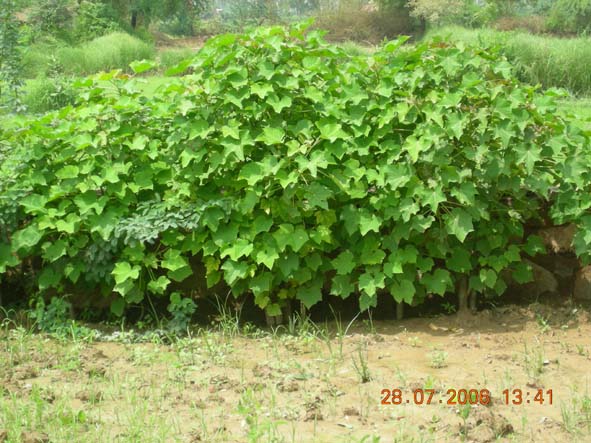

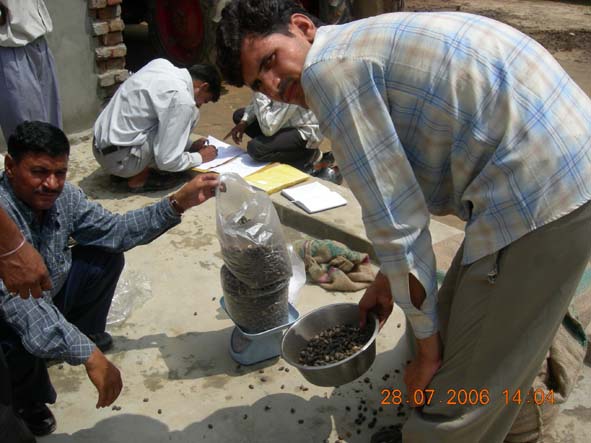
To sum up, village level
management of programmes through people’s
own committees and organizations will ensure sustainability and continuity
of the programme.
Over time a knowledge bank will be created within the people themselves,
and they can take care of most of their problems. External dependence
will be reduced in terms of dissemination of new findings and information
etc, from time to time.
With experience the group will be able to independently access certain
funds from government and other sources as well.
4.11 Role of Private Sector in the Promotion of Sustainable Energy Technologies
in Nepal
Nepal is a mountainous country with rugged terrain and several perennial
streams, rivulets and rivers. In the mid and high hills of the country,
Traditional Water Mills (TWM) or Ghattas, are located on the banks of
these water sources that– for centuries- have been part of rural
communities and are used as an important energy source for grinding cereals.
As per an estimate 25,000 to 30,000 mills are in operation in the country,
one unit typically servicing 20- 50 households. Because of their low
efficiency, the traditional water mills are hardly able to cope with
the increasing food-processing needs of the local communities, resulting
in to their place is be taken over by the diesels powered mills, and
to a lesser extent micro hydro mills. These modern mills are neither
environmentally benign nor sustainable as they use imported machinery
operate on diesel fuel, which drains the countries foreign exchange and
creates atmospheric pollutions.
 An Improved Water Mill (IWM) has been developed that has almost double
the efficiency of the traditional water mills and also improves performance
as well as reliability without changing the traditional management system.
The improved water mill technology is a modified version of the traditional
water mills designed on the principals of Impulse Turbine.
An Improved Water Mill (IWM) has been developed that has almost double
the efficiency of the traditional water mills and also improves performance
as well as reliability without changing the traditional management system.
The improved water mill technology is a modified version of the traditional
water mills designed on the principals of Impulse Turbine.
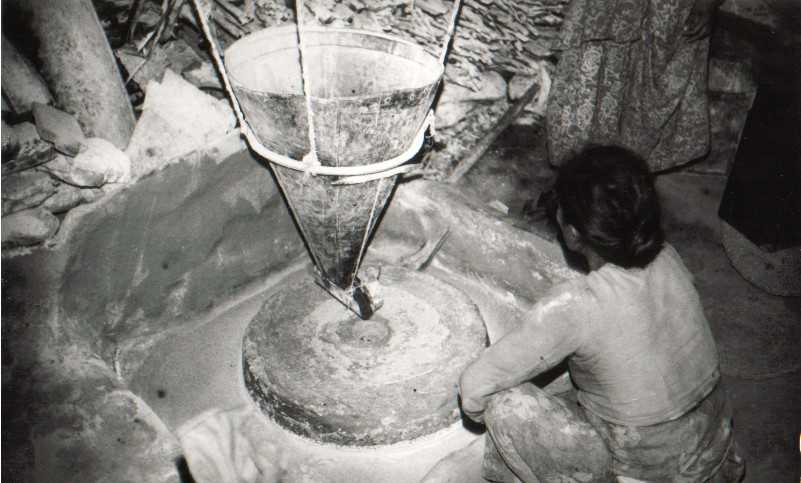
The technology has a direct impact as it can be used for a longer period
into dry season and- through their increased energy output- the quality
of the milling services offered to the local community improves. The
improved service quality is translated into a higher agro processing
capacity (milling capacity often doubles) and/or diversified range
of services (hulling, oil expelling, saw milling etc). An IWM also
generates electricity for remote villages contributing to the quality
of their livelihood.
The history of IWM development in Nepal dates back to 1984, when the
German Appropriate Technology Exchange of the German Technical Cooperation
(GTZ/GATE) initiated a programme aiming for dissemination of IWM. From
1990 onwards the Centre for Rural Technology, Nepal (CRT/N), with the
assistance of GTZ and other development organisations, has actively involved
in the promotion and dissemination of IWM through supporting traditional
Ghatta (Water Mill) owners for improvement.
IWM Program has adopted approaches that lead towards making the program
sustainable. It has emphasized for active collaboration and participation
of private-public sector partnership on the basis of their comparative
advantage regarding different aspects of the programme.
The focus has been given for the effective institutional linkages among
the program partners such as Centre for Rural Technology, Nepal (CRT/N)
as implementing agency, Alternative Energy Promotion Centre (AEPC), the
government’s wing for the promotion of alternative energy and executing
agency of IWM program, SNV/Nepal representing the donor, development
organizations involved in the promotion of the technology, Service Providers,
Water Mill Owners and its Users.
The private sector organizations, including the NGO has been playing
key role in the effective delivery of quality services for the promotion
and dissemination of the technology in Nepal. Major private organizations
involved for the delivery of various services in the programme are as
follows:
-
CRT/N is the lead organization responsible for the implementation of the whole programme. Within the framework of the programme, CRT/N has worked closely with government agencies, donors, development organizations, I/NGOs, private sector organizations and service providers etc. for its smooth implementation.
-
IWM Service Centres are private sector entity, pre-qualified by the programme to work at the local level, and are key actors in delivering socio-technical services required by the mill owners. Presently 16 IWM Service Centres are working in 16 districts, one in each district. They are responsible for inventory of water mills in programme districts, social mobilization, Water Mill Owners' Group/ Association formation, Orientation/Demonstration organization, feasibility survey, procurement of IWM components from manufacturers, linking with micro-financing institutions to facilitate credit support to interested mill owners, installation of IWMs and providing after sale services.
-
Private workshops and manufacturers are responsible to produce standard kits suitable for various end use purposes as per required by the mill owners. Presently there are 8 manufacturers pre-qualified by the programme for ensuring the supply of quality products. The quality of the products is checked and controlled by CRT/N.
-
The Micro-finance Institutions (MFIs) are also key players, responsible basically to administer credit support to interested mill owners in coordination with IWM Service Centres, though MFIs are still not so organized on the delivery of required credit to the millers. Therefore, at present, the IWM installation is mostly done through self-financing by the millers themselves with some subsidy support for the installation activities.
-
Water Mill Owners' Association works mainly as a pressure group for the rights of the mill owners and for awareness campaign among the millers and users not only for IWM promotion but also for social and income generating activities linking with other renewable energy. Some associations are also working as IWM Service Centers and MFIs
-
Local Blacksmiths are available at the local level for the supply of spare parts required for regular repair and maintenance of the technology.
-
There are institutions that undertake various programmes related trainings, studies and assessments, publication related works etc. Their role has been useful in the local capacity building through skill and entrepreneurship development and potential end use diversification.
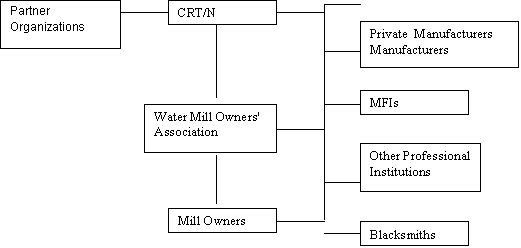
All the private partners have been playing their respective role in an effective manner to make the programme a success. But all the key actors are inter-dependent for effective delivery at the end users level. Sketch below highlights the institutional linkages of private- public sector collaboration:
4.12
Solar Home Lighting (SHL) through Women’s SHGs in Alwar dist,
Rajasthan, India, by SOHARD
Balaheer village belongs to Neemrana block, and lies to the north-western
corner of Alwar district in Rajasthan. Balaheer is a part of the neighbouring
Nangli village, hence popularly known as Nangli Balaheer. It’s
a medium-sized village having a population of 850 people.
Electrification of Balaheer village was a distant dream that meant acute
problems for the community due to lack of power and electricity supply
resulting in numerous problems and more so for the school going children
and women.
SOHARD has installed a total of 44 solar lighting systems to 44 families
on equal financial partnership with the SHG’s. Following strategy
was used for implementation, which led to success: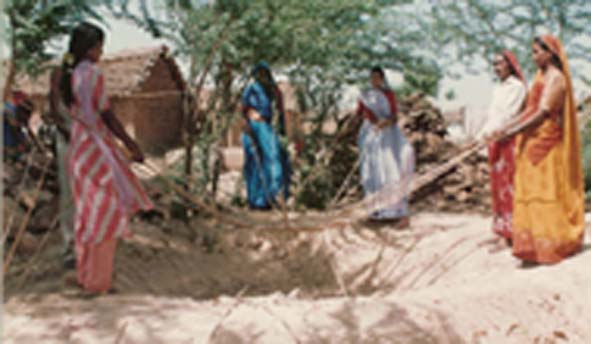
-
Focused on rural women, especially of deprived and marginalized sections of the society.
-
Rapport building with the village community, through active collaboration with the women Self Help Groups (SHGs).
-
Ensuring community participation in the programme by motivating and convincing them to contributes at least 50% share from the villagers for the purchase of SHL system.
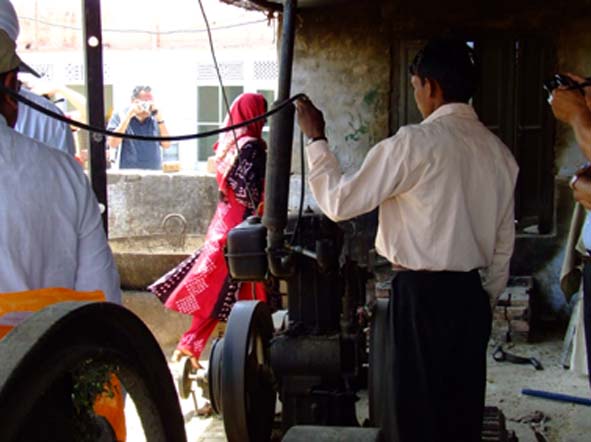
-
Devised proper mobilization- education, capacity building processes and follow-up mechanism for minimum one year for analyzing success and sustainability of the Project.

Providing the solar home lighting system (SHLS) through SHG’s has resulted
in empowerment of the women members of SHG, who were completely involved in the
process. Some of the direct benefits of the SHLS provided to SHG members were
improved performance of their children in studies, due to un-interrupted and
pollution free lighting systems during the night, generation of additional income
Solar Lighting Lamp project progressed due systematic mobilization of people
at the village level and their active participation.


